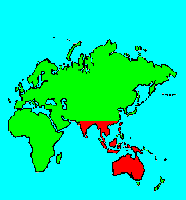SPECIES INFO
Pandanus veitchii is of uncertain origin. However, some scholars believe this plant originated in Polynesia. There is a dwarf form called "Compactus".Pandanus genus (screw pine) contains about 600 species of evergreen shrubs and trees. These species are found in lands around the Indian Ocean, including Madagascar, southeast Asia, Malaysia, Indonesia, and Australia.
Screw Pine Family (Pandanaceae) is found naturally in Africa, Madagascar and east into Asia and further south east into Indonesia, Australia, New Zealand, and east to Hawaii. This is a tropical family of trees and shrubs and a few vines containing about 675 (Some recent counts: 800-900) species in three genera (Pandanus, Freycinetia, Sararanya).
These plants have a woody palm like appearance with linear leaves. There are two genera with four species now growing in greater North America.
Pandanales order is considered the most primitive of the Monocots. The order contains three families, including the well-known cattail family. The bur-reeds and screw-pines belong here also. (Various scientists divide this order in different manners.)
Monocots are a large group of plants usually characterized by having leaves with parallel veins and a seed with a single shell. Most flowers are created with multiples of three. In the older botany texts, the Monocots were considered more primitive than the Dicots. However, many recent authors have placed the Monocots as an offshoot of the primitive Dicots. Here they are placed before the Dicots.
In l951 Lawrence at Cornell published a very detailed plant taxonomy for vascular plants. His taxonomy is very useful as he provided both a detailed explanation and also covered many genera. In the l990s Cronquist published a new plant taxonomy that improved the older taxonomy based on new knowledge. About the same time, Dahlgren published a different taxonomy.
Seed plants (Phylum Embryophyta) are generally grouped into one large phylum containing three major classes: the Gymnosperms, the Monocots, and the Dicots. (Some scientists separate the Gymnosperms into a separate phylum and refer to the remaining plants as flowering plants or Angiospermae.)
For North American counts of the number of species in each genus and family, the primary reference has been John T. Kartesz, author of A Synonymized Checklist of the Vascular Flora of the United States, Canada, and Greenland (1994). The geographical scope of his lists include, as part of greater North America, Hawaii, Alaska, Greenland, Puerto Rico, and the Virgin Islands.
Kartesz lists 21,757 species of vascular plants comprising the ferns, gymnosperms and flowering plants as being found in greater North America (including Alaska, Hawaii, Greenland, Puerto Rico and the Virgin Islands.
There are estimates within the scientific world that about half of the listed North American seed plants were originally native with the balance being comprised of Eurasian and tropical plants that have become established.
Plant kingdom contains a large variety of different organisms including mosses, ferns, and seed plants. Most plants manufacture their energy from sunlight and water. Identification of many species is difficult in that most individual plants have characteristics that have variables based on soil moisture, soil chemistry, and sunlight.
Because of the difficulty in learning and identifying different plant groups, specialists have emerged that study only a limited group of plants. These specialists revise the taxonomy and give us detailed descriptions and ranges of the various species. Their results are published in technical journals and written with highly specialized words that apply to a specific group.
On the other hand, there are the nature publishers. These people and companies undertake the challenging task of trying to provide easy to use pictures and descriptions to identify those species.



